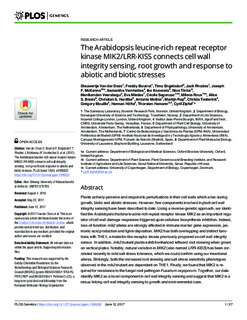| dc.contributor.author | van der Does, Dieuwertje | |
| dc.contributor.author | Boutrot, Freddy | |
| dc.contributor.author | Engelsdorf, Timo | |
| dc.contributor.author | Rhodes, Jack | |
| dc.contributor.author | McKenna, Joseph F. | |
| dc.contributor.author | Vernhettes, Samantha | |
| dc.contributor.author | Koevoets, Iko | |
| dc.contributor.author | Tintor, Nico | |
| dc.contributor.author | Veerabagu, Manikandan | |
| dc.contributor.author | Miedes, Eva | |
| dc.contributor.author | Segonzac, Cecile | |
| dc.contributor.author | Roux, Milena | |
| dc.contributor.author | Breda, Alice S | |
| dc.contributor.author | Hardtke, Christian S. | |
| dc.contributor.author | Molina, Antonio | |
| dc.contributor.author | Rep, Martijn | |
| dc.contributor.author | Testerink, Christa | |
| dc.contributor.author | Mouille, Gregory | |
| dc.contributor.author | Höfte, Herman | |
| dc.contributor.author | Hamann, Thorsten | |
| dc.contributor.author | Zipfel, Cyril | |
| dc.date.accessioned | 2018-07-27T09:25:22Z | |
| dc.date.available | 2018-07-27T09:25:22Z | |
| dc.date.created | 2018-01-02T16:20:16Z | |
| dc.date.issued | 2017 | |
| dc.identifier.citation | PLoS Genetics. 2017, 13 (6). | nb_NO |
| dc.identifier.issn | 1553-7390 | |
| dc.identifier.uri | http://hdl.handle.net/11250/2506670 | |
| dc.description.abstract | Plants actively perceive and respond to perturbations in their cell walls which arise during growth, biotic and abiotic stresses. However, few components involved in plant cell wall integrity sensing have been described to date. Using a reverse-genetic approach, we identified the Arabidopsis thaliana leucine-rich repeat receptor kinase MIK2 as an important regulator of cell wall damage responses triggered upon cellulose biosynthesis inhibition. Indeed, loss-of-function mik2 alleles are strongly affected in immune marker gene expression, jasmonic acid production and lignin deposition. MIK2 has both overlapping and distinct functions with THE1, a malectin-like receptor kinase previously proposed as cell wall integrity sensor. In addition, mik2 mutant plants exhibit enhanced leftward root skewing when grown on vertical plates. Notably, natural variation in MIK2 (also named LRR-KISS) has been correlated recently to mild salt stress tolerance, which we could confirm using our insertional alleles. Strikingly, both the increased root skewing and salt stress sensitivity phenotypes observed in the mik2 mutant are dependent on THE1. Finally, we found that MIK2 is required for resistance to the fungal root pathogen Fusarium oxysporum. Together, our data identify MIK2 as a novel component in cell wall integrity sensing and suggest that MIK2 is a nexus linking cell wall integrity sensing to growth and environmental cues. | nb_NO |
| dc.language.iso | eng | nb_NO |
| dc.publisher | Public Library of Science | nb_NO |
| dc.rights | Navngivelse 4.0 Internasjonal | * |
| dc.rights.uri | http://creativecommons.org/licenses/by/4.0/deed.no | * |
| dc.title | The Arabidopsis leucine-rich repeat receptor kinase MIK2/LRR-KISS connects cell wall integrity sensing, root growth and response to abiotic and biotic stresses. | nb_NO |
| dc.type | Journal article | nb_NO |
| dc.type | Peer reviewed | nb_NO |
| dc.description.version | publishedVersion | nb_NO |
| dc.source.pagenumber | 27 | nb_NO |
| dc.source.volume | 13 | nb_NO |
| dc.source.journal | PLoS Genetics | nb_NO |
| dc.source.issue | 6 | nb_NO |
| dc.identifier.doi | 10.1371/journal.pgen.1006832 | |
| dc.identifier.cristin | 1534125 | |
| dc.description.localcode | : © 2017 Van der Does et al. This is an open access article distributed under the terms of the Creative Commons Attribution License, which permits unrestricted use, distribution, and reproduction in any medium, provided the original author and source are credited. | nb_NO |
| cristin.unitcode | 194,66,10,0 | |
| cristin.unitname | Institutt for biologi | |
| cristin.ispublished | true | |
| cristin.fulltext | original | |
| cristin.qualitycode | 2 | |

